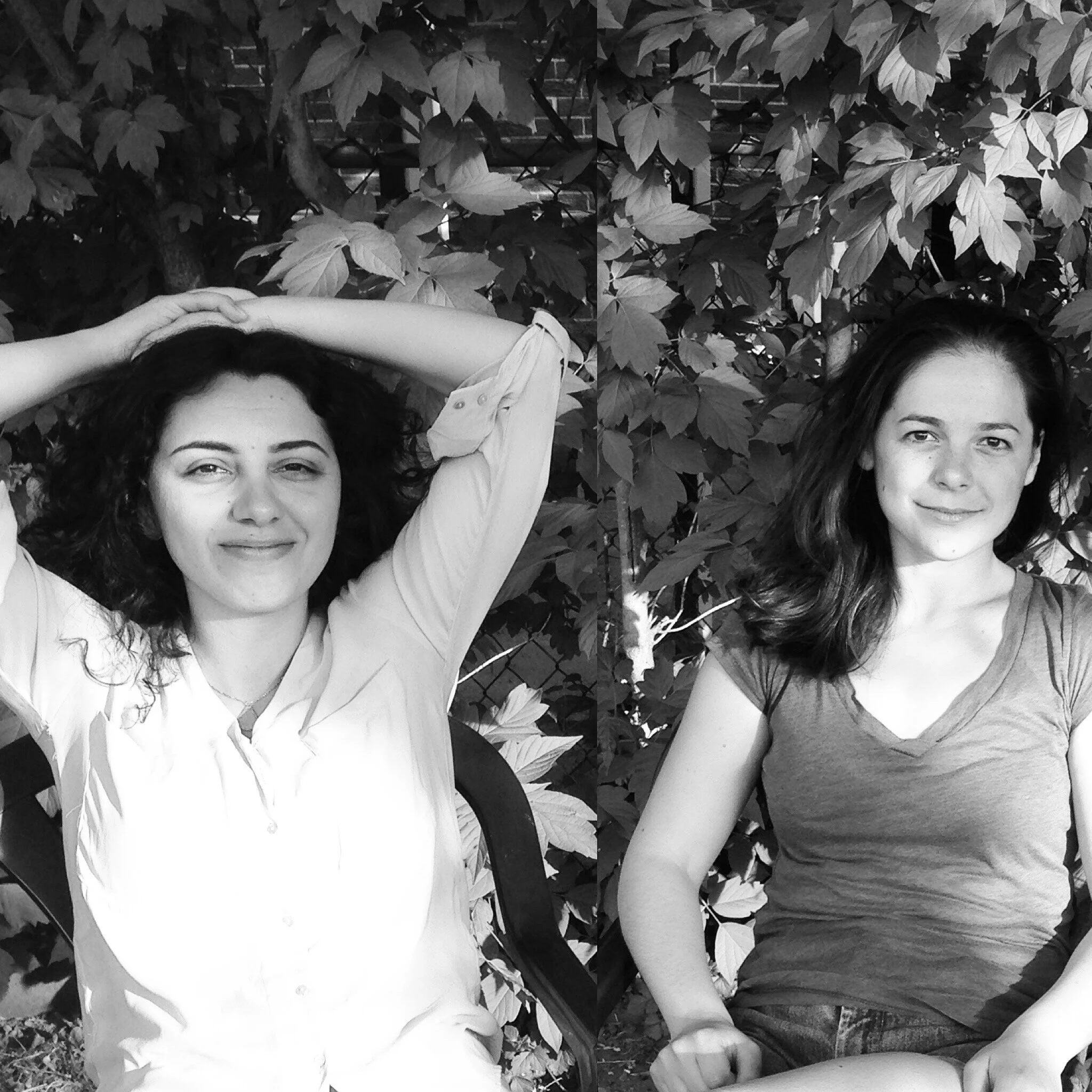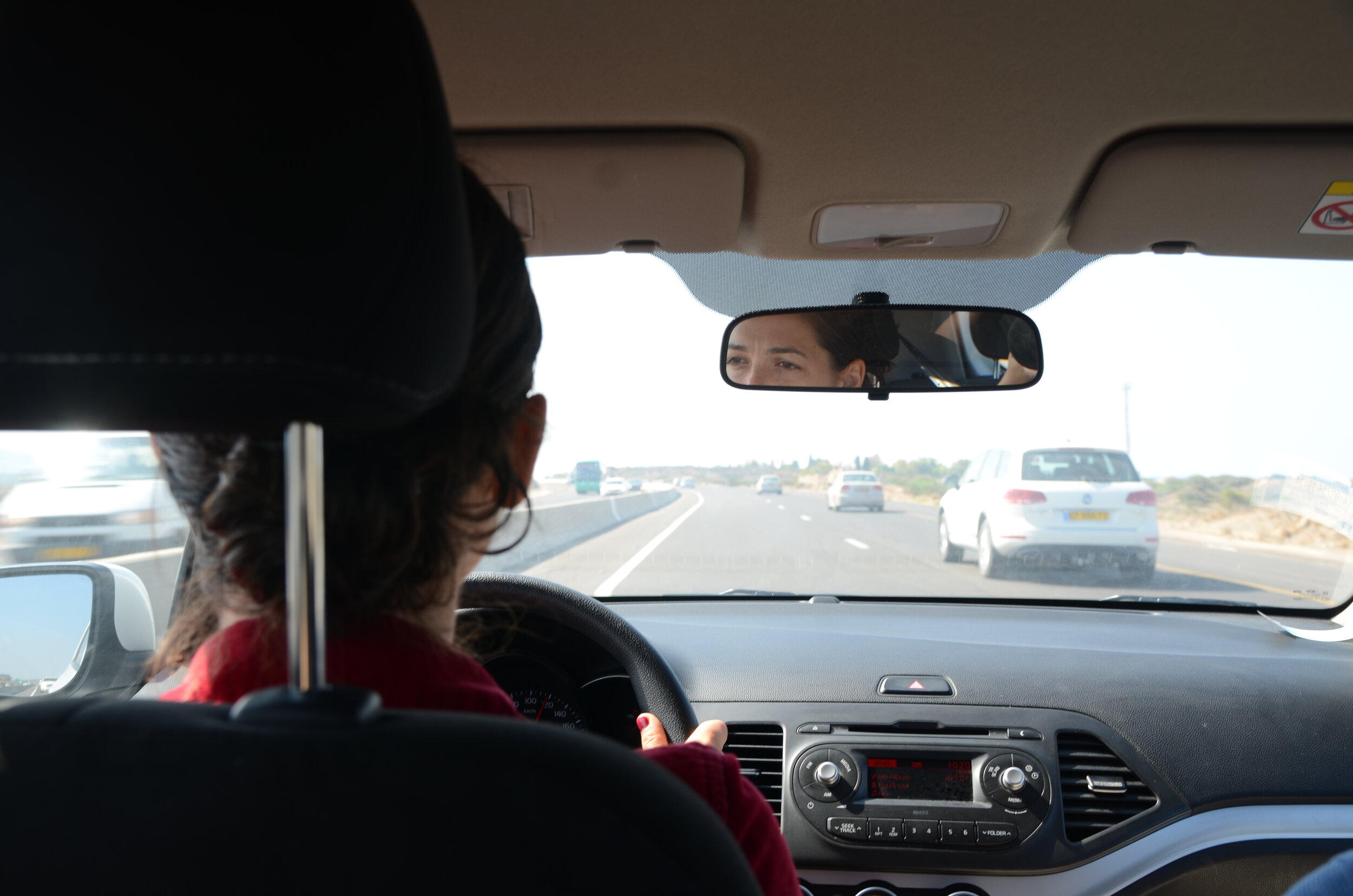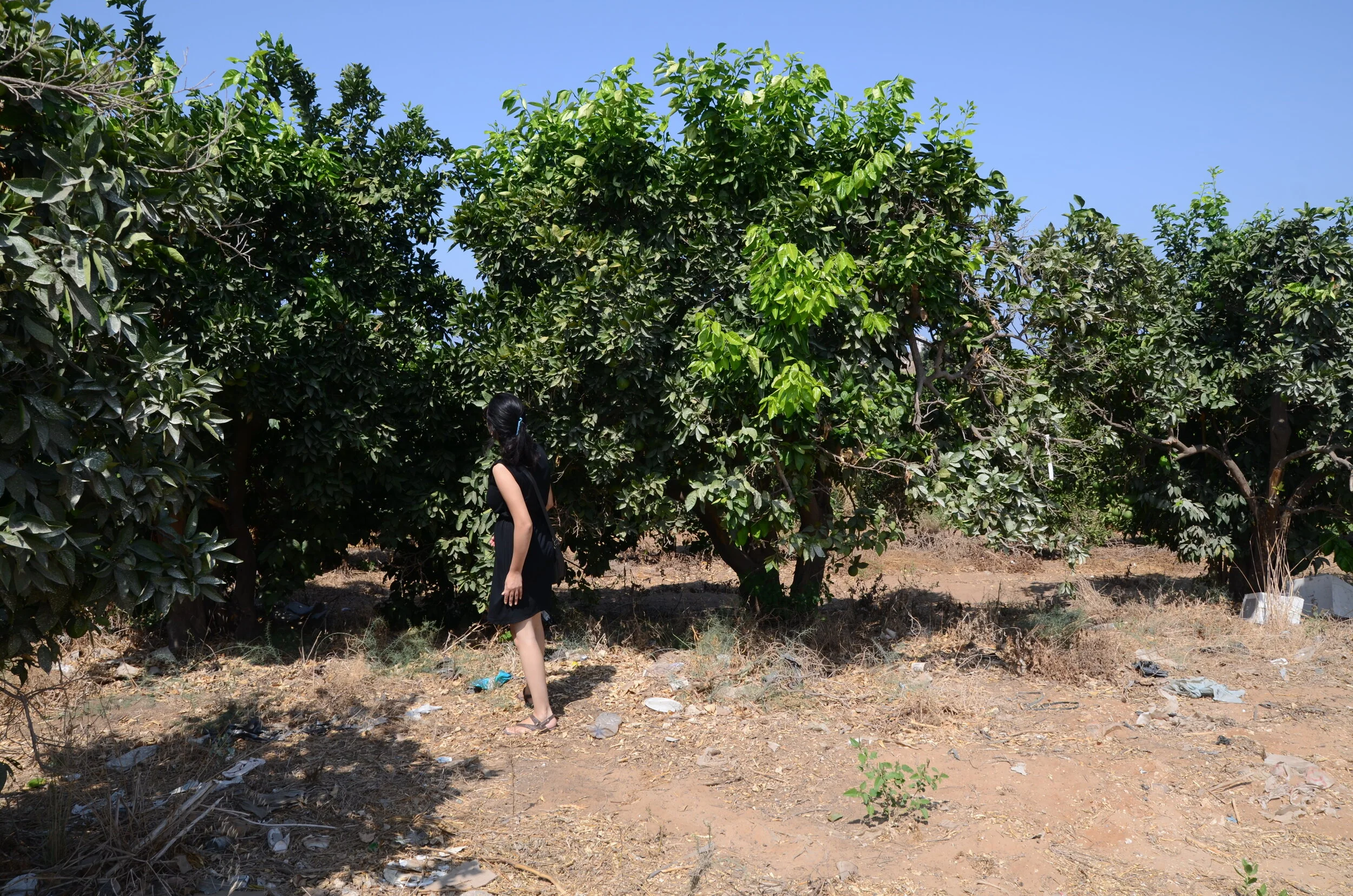Landscape, memory, and fantasy in auto-fictional theatre-making
Natasha Greenblatt and Rimah Jabr
Rimah Jabr and Natasha Greenblatt, “taken the day we wrote our first application with just the idea for the play—before we went to Netanya.” Photo: the artists.
Rimah and I are going to Netanya to research a play we’re writing together. Netanya is a city on the western coast of what is currently called Israel. My great-grandfather bought a house there in 1948, when it was still called Palestine. He never lived there, but he would visit every winter. He always wanted to move there. Our family sold it when he died, long before I was born. Rimah and I are imagining that her grandparents fled a house in Netanya during the Nakba, and that this is the same house my great-grandfather bought there in 1948. Of course, this isn’t exactly true. But we’ve decided to create a story that is both true and false. A fictional documentary. An imaginary landscape we are remembering together.
If I stand on the top of Mount Ebal in Nablus at night, if the sky is clear, I can see the lights of the city of Netanya. These lights, they cover the ruins of the Palestinian village of Umm Khalid. If it wasn’t for this play, I wouldn’t be going there. I wouldn’t be taking this complicated trip to a place that will take me a few hours to reach, a place that should be half an hour’s drive from Nablus without the wall.
Tel Aviv as seen from the western foothills of the West Bank, on the way to Netanya. Photo: Ahmad Al-Bazz.
I’m traveling with my brother Will. We rent a car in Jerusalem and pick up Rimah and her husband Ashraf. They tell us to meet them at the Tayelet, a huge promenade near the edge of a Palestinian neighborhood called Silwan, where Ashraf is from. When I look it up, I read this promenade was designed by famous landscape architects. Built on the site where Jesus was betrayed by Judas, the same place where the Six-Day War erupted. Using stone quarried from local hills, the promenade is flanked by olive trees and wheat fields that recall the groves of the villages that used to be here. The promenade was designed to instill a sense of calm, of peace, of “less tension”. New plans to develop the promenade are now horrifying the landscape architecture community, who say the “mountain of slides” the city is threatening to build will be a “Disneyfication” of this historic site.
I can’t open my eyes for the camera. Ashraf is taking a selfie of us with the golden shining dome behind us at the Tayelet. Ashraf tells me about the time he spent in this neighborhood as a child. I ask him to imagine what he was doing when I was born in 1980. He was six, he used to play in this neighborhood. Maybe he was covered in dust after a soccer game, maybe he was begging his friend to give him a turn on the bicycle. While we’re imagining what he would have been doing, Natasha and her brother Will pull up in a rental car.
We head out of Jerusalem on our way to Netanya. I’m a new driver and this is my first time on a highway. It’s huge and the speed limit is 120 km/hr. I’m not used to driving this fast. I’m terrified. Rimah and Ashraf chant “Natasha, Hareefeh,” which means “Professional Natasha,” as I clutch the steering wheel and keep my foot on the gas, desperately trying to listen to directions from Waze, a GPS tool formerly called FreeMap Israel, now owned by Google.
For me directions are before the wall or behind the wall, past the checkpoint or before the checkpoint. This is what navigating is for a Palestinian.
Natasha driving to Netanya. Photo: Rimah Jabr.
I see rolling green hills to one side, the ocean on the other. Red tiled roofs and stone buildings popping up in clusters of villages. I don’t even think we’re near the wall. Somehow the conflict feels far away here; it’s like a beautiful movie. A road trip with friends. Music playing and Ashraf and Waze helping me hold my nerve and find Netanya.
I never thought I would go back there. This was once the closest beach by car from Nablus. It is now the farthest, because we have to go south to Jerusalem, cross the wall at the Qalandia checkpoint, then travel north again to be in Netanya. I never pictured this happening, driving there with my friends from Canada and my lover from Jerusalem.
As we get closer there are more and more box stores: Ikea, North Face, Best Buy. It reminds me of the vast stretches of suburbia you have to drive through before you get to any city in Canada, except here, there are palm trees everywhere.
We get to the city hall to try and find a record of the house my great-grandfather bought in Netanya in 1948. The house he hoped to live in but never did. We speak to an old man at the front desk and tell him my story. He tells us he’s very happy to see beautiful Jewish people coming home, but we really have to go to the Tabo, the land registry, and it will be closed for the day. We should come back tomorrow. Ashraf says yom tov, which means “have a nice day” in Hebrew. I want to say “thank you” in Hebrew, but instead I say shukran which is “thank you” in Arabic, because I’ve been traveling through the West Bank and it’s become a habit. The old man’s smile fades. He looks very confused. We leave quickly, laughing. Rimah says, “This will be good for our play.” Will says, “Where can we find some food?”
My family never fled Umm Khalid in 1948. This part of the play will be fiction, inspired by someone else’s story. My family lived in Tubas, a village near Nablus in the West Bank. And my family did run from our home; but it was in 1967, during the Six-Day War, when Israel occupied the whole of Palestine. Luckily my grandfather decided to go back home halfway through their journey to Jordan. I try to imagine what it feels like to be a Palestinian from Umm Khalid. Where would I be?
A lot of the cafe signs are in French, with drawings of baguettes and croissants. Someone told us that Netanya is the Little Paris of Israel: lots of Jews immigrated here from France and French-speaking countries like Morocco and Tunisia. We eat a falafel sandwich that has an egg in it and then we decide to head to the beach.
I expected Netanya to be cleaner. It is a coastal town but obviously the people who lived here didn’t pay attention to that. It was rushed. I miss the culture that comes out of the feeling of belonging. The character of a city that’s been built over time. I see visual noise and red heat. I smell dead fish.
When I was little, my family used to go to the east coast of Canada during the summer. We would drive for 16 hours to get to a tiny shack on the top of a cliff. My mother would let me walk down the wooden stairs and play in the ocean by myself. She could see me from up high and she knew the water was too cold to be dangerous. I was alone, free, covered in sand and salty water.
I’ve been here before. I only remember my five-year-old feet half floating in the salty water, ten centimetres deep, not more, but it was enough to give me feelings of pleasure and discovery. After this trip I never saw the sea again, except for on a screen.
The Mediterranean, seen from one of Netanya's beach fronts. Photo: Shachaf Polakow.
As soon as we see the ocean Will and I strip down to our bathing suits and run in. Rimah and Ashraf stay by the shore. We float, staring up at the blue skies and palm trees. A strange Florida beach town in the middle of a country defined by occupation, conflict, and violence.
I always imagined that swimming is something anyone can do. But here I am walking carefully at the edge of the sea. These waves have witnessed everything that happened on this shore. They’ve bid farewell to people leaving and greeted other people arriving. Yes, we decided to make a play. We begin with two names: Netanya and Umm Khalid. Umm means mother. There must be a woman’s story behind this name. In the play I will make my grandmother sit here, watching the sea, talking about love. I don’t know what Netanya means. I should look it up.
That night, in Haifa, we go to a Palestinian bar full of hipsters playing free jazz. We look up Netanya on Ashraf’s phone. It was formed in 1929, when Zionist settlers bought land near a village called Umm Khalid. Netanya was named after the Jewish-American philanthropist Nathan Strauss who was a co-owner of Macy’s, in the hopes that he would donate money to the new city. But he never did. Umm Khalid was a small village, with 900 people living there in the 1940s. It is thought to have been continuously inhabited from the time of the Crusades until 1948 when, during the Nakba, the villagers were forced out of their homes. The ruins of the village were eventually incorporated into the city of Netanya.
I would love to go black and white, to be in that period I see in the photos, when life was perfect and romantic. I can’t be specific, I can’t be sure if there ever was a peaceful period in Palestine.
The next day we’re back in the car looking for the Tabo. Waze leads us to an orange grove in the middle of a construction site. We wander around, taking pictures next to the trees. The oranges are almost the size of our heads.
It’s as if the orange trees have stopped documenting their seasonal stories. I believe the orange blossoms are like eyes: they witness the stories that happen around them. And they leave their records in the tree itself. I remember our science teacher telling us if we cut the trunk of any tree horizontally and look at the circles inside, it will tell us its age. Each circle means one year. I believe all those circles in the tree trunk are a record of each year that’s passed.
I look at the trees and I feel they have forgotten those past years and the memories that once lived inside them. They love their new caregivers, they grow wildly and beautifully. The colors are impressive, the fruit grows intensely. I’m jealous of the owner of this grove.
Rimah in the orange grove. Photo: Natasha Greenblatt.
Finally, we find the Tabo. It’s a small building. You wouldn’t see it unless you knew it was there. We go inside and take a tiny elevator with an old Jewish man wearing a big hat. We’re brought to speak to a woman in a small office. I go in while Rimah, Ashraf, and Will sit in the lobby. She asks if I have a block number? No, I say. How it works in Israel, she tells me, is that there are block numbers, and inside the block numbers there are parcel numbers. If I had that, then I would need a court order to find the house. She asks if I have his ID number? A passport? I really only know his name and the date. You need to find old documents, she says, if he was that passionate maybe he kept some documents.
A country is divided by stories. When we describe a road to our house in Nablus, for example, we tell the story of the street: Here is X’s mini market, which is at a corner. X chose a corner as a strategic spot in order to be near the family of Y; their house is behind the playground that was named after a woman who lived alone. When she died, she left all her money to build a school for girls. We map the area with stories.
I realize how ridiculous it is, looking for a house with just a name and a date. A fantasy of belonging. A fantasy I shared with my great-grandfather who left the pogroms and poverty of Poland in search of something new. Maybe this will be good for the play?
Netanya, 2019. Photo: Shachaf Polakow.
Umm means mother. Umm Khalid was named after a righteous woman who lived and died in that village. She was buried there. When the Nakba happened I wasn’t born yet but I imagine myself standing barefoot in the middle of the road on a green hill watching all these people leave their homes. They keep haunting me, asking me to tell their stories.
My great-grandfather never learned to read and write in English. So my grandmother, his daughter, always wrote to him in Yiddish. She spent a long time trying to fit into the Christian world around her. To assimilate. Her relationship with Judaism was complicated by the abuse she was subjected to by a Zionist rabbi who was her father’s friend. I decide not to include that part in the play. My great grandfather would never go back to Poland where his entire family were killed, but he returned again and again to Netanya. Imaginary landscapes carved through trauma.
When Natasha’s great-grandfather first arrived in Netanya in search of a new life in 1948, my grandmother was a young woman of 22 years old, 61 km away in a village called Tubas. She was pregnant with my father, she had long strands of hair, she told me that she worked in the field sometimes with farmers, she said that life was shining and the future seemed beautiful. For as long as I can remember, Kareema lived with my family. Near the end of her life, she didn’t talk much. All she did was watch T.V. She didn't know anything about theatre. When I told her that she was going to be a character in my play, she said, “When are you getting married?”
We read that in 1997 when some land was being razed to build a school in Netanya, they uncovered the old cemetery of Umm Khalid. There was a petition to stop the development and save the consecrated ground. It was successful. As a result they put up a plaque which reads: Here is the Muslim cemetery of the village of Umm Khalid. We put on Waze and drive around to search for the plaque. We listen to pop music, interrupted by a woman’s digitized voice saying, “In 50 meters turn left. You will arrive at your destination.”
~
Rimah and Natasha in Two Birds One Stone, first produced at Why Not Theatre’s the Riser Project in Toronto in 2017; it was remounted at the Tarragon Theatre in 2018 and has since played at Impact Festival in Kitchener and the Winnipeg Jewish Theatre. Photo: Dahlia Katz.
ABOUT THE WRITERS
Natasha Greenblatt is a Jewish Canadian playwright, actor, educator and the co-artistic director of Two Birds Theatre. Her plays include The Peace Maker (Next Stage Festival, published by Playwrights Canada Press as part of the anthology “Double Exposure: Plays of the Jewish and Palestinian Diasporas”); The Election, a collaboration with playwright Yolanda Bonnell and the company (produced by Common Boots Theatre, Nightwood Theatre, and Theatre Direct presented at Theatre Passe Muraille); and The Apocalypse Plays: A Legacy Project with her mother, theatre-maker Kate Lushington (produced by Two Birds Theatre at the Rhubarb Festival). She will be starting her M.F.A. in Creative Writing at the University of Guelph this fall.
Rimah Jabr moved to Toronto in 2016, where she collaborated with Natasha Greenblatt to create Two Birds One Stone. Rimah is a Palestinian theatre-maker and co-artistic director of Two Birds Theatre. Rimah got her Masters in Drama at Erasmus Hogeschool Brussel RITCS in 2014. Rimah has written several plays that have been produced in Belgium and Toronto, including Two Ladybugs, The Prisoner, High Heels and Stuffed Zucchini, and This Is Not What I Want To Tell You. Rimah is an artist in the Residency program at The Theatre Centre in Toronto. She is currently a Ph.D. student in Theatre and Performance Studies at York University.








